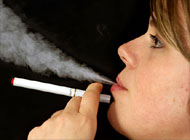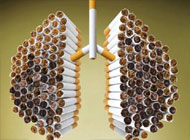Current cigarette smokers at increased risk of seizures
A recent study determined there is a significant risk of seizure for individuals who currently smoke cigarettes. Boston-based researchers from Brigham and Women’s Hospital and Harvard Medical School also found that long-term, moderate intake of caffeine or alcohol does not increase the chance of having a seizure or developing epilepsy. This is the first prospective study to examine the potential risks associated with cigarette smoking, caffeine intake, and alcohol consumption as they independently relate to epilepsy. Full findings of this study are currently available online and will appear in the February 2010 issue of Epilepsia, a journal published by Wiley-Blackwell on behalf of the International League Against Epilepsy.
Epilepsy is a neurological condition characterized by repeated unprovoked seizures where electrical disturbances in the brain cause sudden, involuntary changes in body movements (convulsions and muscle spasms) and sensory awareness. Approximately 2.5 million Americans are affected by epilepsy with 150,000 new cases diagnosed this year alone, according to the Centers for Disease Control and Prevention (CDC). The CDC further estimates that epilepsy accounts for $15.5 billion in medical costs and lost earnings. Single seizures or those provoked by alcohol withdrawal or other cause are even more common, occurring in up to 10% of the population.
Barbara A. Dworetzky, M.D., and colleagues used data obtained from the Nurses’ Health Study II, a group of 116,608 female registered nurses, aged 25-42 years old who returned mailed questionnaires on their lifestyle and medical history including epilepsy and seizure activity.
In the analysis for cigarette smoking, researchers accrued 246 cases and 1,778,307 person-years of follow-up among 116,363 participants. For the analyses of caffeine intake, there were 201 cases and 1,440,850 person-years of follow-up among 105,941 participants, and for the alcohol consumption analyses, 198 cases and 1,427,348 person-years of follow-up among 104,934 participants. The data used in this study were obtained from 1989 through May 31, 2005.
After adjusting for stroke, brain tumor, hypertension and other potential confounding factors, researchers observed a significant association between current cigarette smoking and risk of seizure (relative risk (RR) of 2.60). “Our analysis showed risk of seizure was significantly higher for current smokers, but not related to the amount of cigarettes smoked daily,” said Dr. Dworetzky. “It does appear, however, that the number of years of smoking does increase seizure risk.” Risk of epilepsy, that is recurrent unprovoked seizures, was modestly elevated with both past (RR - 1.46) and current smoking (RR - 1.27), but not statistically significant.
 The analysis of caffeine consumption showed that a long-term average intake of ≥ 400 mg of caffeine/day compared with
The analysis of caffeine consumption showed that a long-term average intake of ≥ 400 mg of caffeine/day compared with
<200 mg/day was not associated with greater risk of seizures or epilepsy (RR - 0.77 and 0.97 respectively). Researchers also observed no trend of increasing seizure or epilepsy risk with increasing caffeine consumption.
Further results indicate that risk of seizures or epilepsy was not significantly different between moderate alcohol drinkers (0.1-15.9 g/day) and alcohol abstainers. Study authors did not find that heavy alcohol consumption (15.1-30.0 g/day) was associated with risk of seizure or epilepsy.
This study cohort was primarily comprised of Caucasian (91%) women who had better health knowledge and access to healthcare than women in the general population. "Given the composition of the study group, our findings may not apply to men, younger or older populations, groups with lower socioeconomic status or lower attained education, or populations with higher percentages of minorities," advised Dr. Dworetzky. The authors suggest that further studies are needed to increase knowledge of modifiable risk factors to prevent seizures and epilepsy.
###

Article: “A prospective study of smoking, caffeine, and alcohol as risk factors for seizures or epilepsy in young adult women: Data from the Nurses’ Health Study II.” Barbara A. Dworetzky, Edward B. Bromfield, Mary K. Townsend, and Jae H. Kang. Epilepsia; Published Online (early view): August 2009 (DOI: 10.1111/j.1528-1167.2009.02268.x); Print Issue Date: February 2010
This study is published in Epilepsia. Media wishing to receive a PDF of this article may contact .(JavaScript must be enabled to view this email address)
To view the abstract for this article, please click here.
Epilepsia is the leading, most authoritative source for current clinical and research results on all aspects of epilepsy. As the journal of the International League Against Epilepsy, subscribers every month will review scientific evidence and clinical methodology in: clinical neurology, neurophysiology, molecular biology, neuroimaging, neurochemistry, neurosurgery, pharmacology, neuroepidemiology, and therapeutic trials. For more information, please visit http://www3.interscience.wiley.com/journal/117957420/home.
Wiley-Blackwell is the international scientific, technical, medical, and scholarly publishing business of John Wiley & Sons, with strengths in every major academic and professional field and partnerships with many of the world’s leading societies. Wiley-Blackwell publishes nearly 1,500 peer-reviewed journals and 1,500+ new books annually in print and online, as well as databases, major reference works and laboratory protocols.
Contact: Dawn Peters
.(JavaScript must be enabled to view this email address)
781-388-8408
Wiley-Blackwell